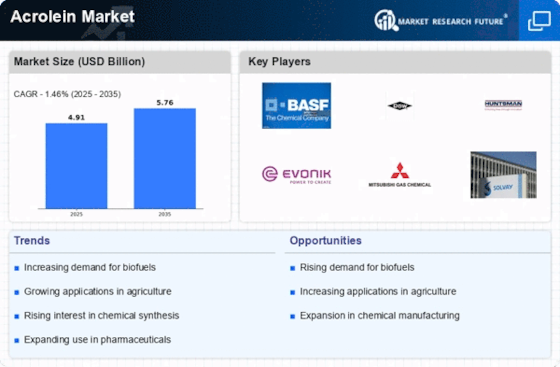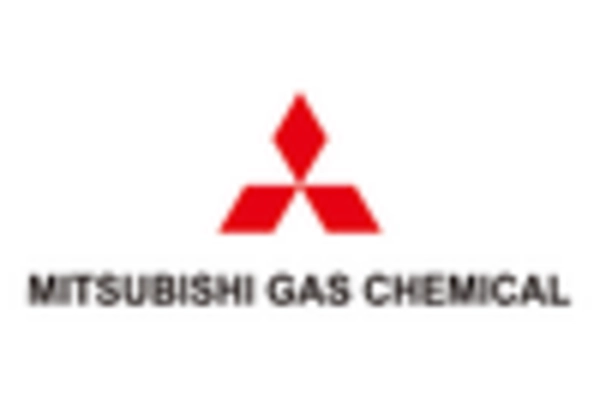Expansion of the Automotive Sector
The automotive sector's expansion plays a crucial role in the Acrolein Market, as acrolein is utilized in the production of various automotive components. The increasing focus on lightweight materials and fuel efficiency has led to a surge in demand for advanced composites and plastics, which often incorporate acrylics derived from acrolein. In 2025, the automotive industry is expected to witness a growth rate of around 4% annually, further driving the need for acrolein-based products. This trend suggests that as automotive manufacturers continue to innovate and enhance vehicle performance, the acrolein market will likely benefit from increased consumption in this sector.
Growth in Personal Care and Cosmetics
The personal care and cosmetics sector is emerging as a significant driver for the Acrolein Market. Acrolein is increasingly used in the formulation of various personal care products, including skin care, hair care, and fragrances. The Acrolein is projected to reach approximately 800 billion USD by 2025, with a growing emphasis on innovative and effective formulations. This growth is likely to enhance the demand for acrolein, as manufacturers seek to incorporate high-performance ingredients that offer improved efficacy. The rising consumer awareness regarding product quality and safety further underscores the potential for acrolein in this dynamic market.
Rising Demand for Chemical Intermediates
The Acrolein Market is experiencing a notable increase in demand for chemical intermediates, particularly in the production of acrylic acid and other derivatives. This trend is driven by the expanding applications of acrylics in various sectors, including paints, coatings, and adhesives. As industries seek to enhance product performance and durability, the need for high-quality chemical intermediates becomes paramount. In 2025, the demand for acrylic acid, a primary derivative of acrolein, is projected to reach approximately 6 million tons, indicating a robust growth trajectory. This rising demand for chemical intermediates is likely to propel the acrolein market further, as manufacturers strive to meet the evolving needs of end-users.
Increasing Focus on Sustainable Practices
The Acrolein Market is witnessing a shift towards sustainable practices, driven by the growing emphasis on environmental responsibility. Manufacturers are increasingly adopting eco-friendly production methods and sourcing raw materials from renewable resources. This trend aligns with the broader movement towards sustainability across various industries, including chemicals and materials. In 2025, it is anticipated that the market for bio-based chemicals, including acrolein, will experience a compound annual growth rate of around 5%. This focus on sustainability not only enhances the market's appeal but also positions acrolein as a viable alternative in applications where traditional petrochemical sources are being scrutinized.
Technological Advancements in Production Processes
Technological advancements in production processes are significantly influencing the Acrolein Market. Innovations in catalytic processes and reaction engineering are enhancing the efficiency and yield of acrolein production. These advancements are expected to reduce production costs and improve the overall sustainability of acrolein manufacturing. In 2025, the implementation of advanced technologies is projected to increase production capacity by approximately 15%, thereby meeting the rising demand from various end-use industries. This technological evolution not only supports the growth of the acrolein market but also encourages manufacturers to explore new applications and formulations, further diversifying the market landscape.

















Leave a Comment